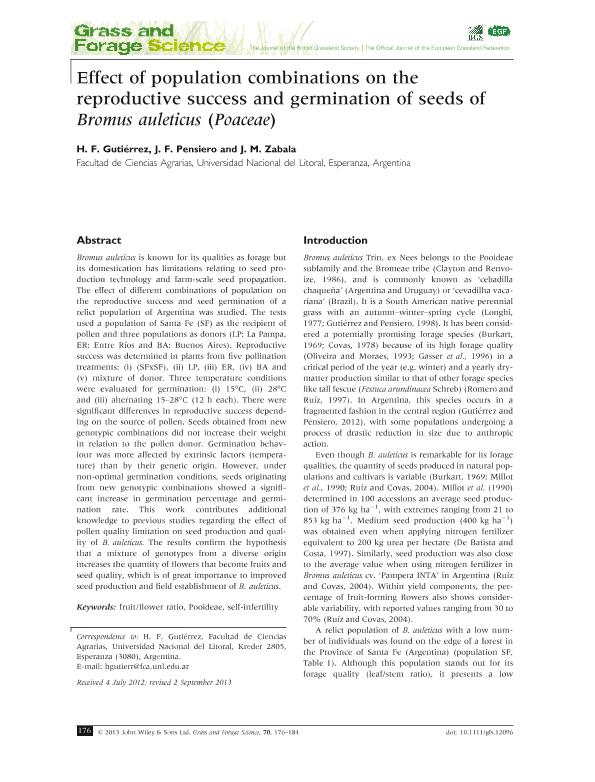Mostrar el registro sencillo del ítem
dc.contributor.author
Gutiérrez, Hugo Francisco

dc.contributor.author
Pensiero, Jose Francisco

dc.contributor.author
Zabala, Juan Marcelo

dc.date.available
2018-02-28T19:42:44Z
dc.date.issued
2015-03
dc.identifier.citation
Gutiérrez, Hugo Francisco; Pensiero, Jose Francisco; Zabala, Juan Marcelo; Effect of population combinations on the reproductive success and germination of seeds of Bromus auleticus (Poaceae); Wiley; Grass and Forage Science; 70; 1; 3-2015; 176-184
dc.identifier.issn
0142-5242
dc.identifier.uri
http://hdl.handle.net/11336/37480
dc.description.abstract
Bromus auleticus is known for its qualities as forage but its domestication has limitations relating to seed production technology and farm-scale seed propagation. The effect of different combinations of population on the reproductive success and seed germination of a relict population of Argentina was studied. The tests used a population of Santa Fe (SF) as the recipient of pollen and three populations as donors (LP: La Pampa, ER: Entre Ríos and BA: Buenos Aires). Reproductive success was determined in plants from five pollination treatments: (i) (SFxSF), (ii) LP, (iii) ER, (iv) BA and (v) mixture of donor. Three temperature conditions were evaluated for germination: (i) 15°C, (ii) 28°C and (iii) alternating 15-28°C (12 h each). There were significant differences in reproductive success depending on the source of pollen. Seeds obtained from new genotypic combinations did not increase their weight in relation to the pollen donor. Germination behaviour was more affected by extrinsic factors (temperature) than by their genetic origin. However, under non-optimal germination conditions, seeds originating from new genotypic combinations showed a significant increase in germination percentage and germination rate. This work contributes additional knowledge to previous studies regarding the effect of pollen quality limitation on seed production and quality of B. auleticus. The results confirm the hypothesis that a mixture of genotypes from a diverse origin increases the quantity of flowers that become fruits and seed quality, which is of great importance to improved seed production and field establishment of B. auleticus.
dc.format
application/pdf
dc.language.iso
eng
dc.publisher
Wiley

dc.rights
info:eu-repo/semantics/openAccess
dc.rights.uri
https://creativecommons.org/licenses/by-nc-sa/2.5/ar/
dc.subject
Fruit/Flower Ratio
dc.subject
Pooideae
dc.subject
Self-Infertility
dc.subject.classification
Agricultura

dc.subject.classification
Agricultura, Silvicultura y Pesca

dc.subject.classification
CIENCIAS AGRÍCOLAS

dc.title
Effect of population combinations on the reproductive success and germination of seeds of Bromus auleticus (Poaceae)
dc.type
info:eu-repo/semantics/article
dc.type
info:ar-repo/semantics/artículo
dc.type
info:eu-repo/semantics/publishedVersion
dc.date.updated
2018-02-28T14:28:47Z
dc.journal.volume
70
dc.journal.number
1
dc.journal.pagination
176-184
dc.journal.pais
Reino Unido

dc.journal.ciudad
Londres
dc.description.fil
Fil: Gutiérrez, Hugo Francisco. Consejo Nacional de Investigaciones Científicas y Técnicas. Centro Científico Tecnológico Conicet - Santa Fe; Argentina. Universidad Nacional del Litoral. Facultad de Ciencias Agrarias; Argentina
dc.description.fil
Fil: Pensiero, Jose Francisco. Consejo Nacional de Investigaciones Científicas y Técnicas. Centro Científico Tecnológico Conicet - Santa Fe; Argentina. Universidad Nacional del Litoral. Facultad de Ciencias Agrarias; Argentina
dc.description.fil
Fil: Zabala, Juan Marcelo. Consejo Nacional de Investigaciones Científicas y Técnicas. Centro Científico Tecnológico Conicet - Santa Fe; Argentina. Universidad Nacional del Litoral. Facultad de Ciencias Agrarias; Argentina
dc.journal.title
Grass and Forage Science

dc.relation.alternativeid
info:eu-repo/semantics/altIdentifier/url/http://onlinelibrary.wiley.com/doi/10.1111/gfs.12096/abstract
dc.relation.alternativeid
info:eu-repo/semantics/altIdentifier/doi/http://dx.doi.org/10.1111/gfs.12096
Archivos asociados
